Characteristics of Extremely Over-Indebted Economies
Economics / Global Debt Crisis 2015 Apr 21, 2015 - 07:07 AM GMTBy: John_Mauldin
 I think it was almost two years ago that I was in Cyprus. Cyprus had just come through its crisis and was still in shell shock. I was there to get a feel for what it was like, and a number of my readers had courteously arranged for me to meet with all sorts of people and do a few presentations. A local group arranged for me to speak at the lecture hall of the Central Bank of Cyprus in Nicosia.
I think it was almost two years ago that I was in Cyprus. Cyprus had just come through its crisis and was still in shell shock. I was there to get a feel for what it was like, and a number of my readers had courteously arranged for me to meet with all sorts of people and do a few presentations. A local group arranged for me to speak at the lecture hall of the Central Bank of Cyprus in Nicosia.
There were about 50 people in the room. I was busily working on Code Red at the time and had money flows, quantitative easing, and currency wars at the front of my brain. As part of my presentation, I talked about how countries would seek to use currency devaluation in order to gain an advantage over other countries – that we were getting ready to enter an era of currency wars, which would be disguised as monetary policy trying to create economic growth. Which is exactly what we have today. Every now and then I get a few things right.
After my short presentation, during the question and answer period, I pointed to a distinguished-looking gentleman to ask the fourth question. Before he could get his question out, my host stood up and said, “John, I just want to give you fair warning. This is Christopher Pissarides. He recently won the Nobel Prize in economics and is a professor at the London School of Economics, as well as being a Cypriot citizen.”
Professor Pissarides preceded his question by citing a great deal of literature, some of it his own, which showed that a country could not gain a true advantage by engaging in currency manipulation. “So why do you think there would be currency wars? What would it gain anybody?” he asked.
We proceeded to have a conversation that basically boiled down to the old Yogi Berra maxim: In theory, theory and practice are the same thing. In practice they differ.
Dr. Pissarides was of course absolutely right. Beggar-thy-neighbor policies end up making everybody worse off at the end of the day. However, there is a short-term first-mover advantage. In a short-term world, people do things to show they are being “proactive.” And in a world of “every central banker for himself,” where central banks are essentially trying to position their countries to prosper, you wind up having multiple iterations of tit for tat.
And that is just one of the points that our old friend Lacy Hunt of Hoisington Management makes in this week’s Outside the Box:
In our review of historical and present cases of over-indebtedness, we noticed some overlapping tendencies with less regularity that are important to mention.
First, when all major economies face severe debt overhangs, no one country is able to serve as the world’s engine of growth. This condition is just as much present today as it was in the 1920-30s.
Second, currency depreciations result as countries try to boost economic growth at the expense of others. Countries are forced to do this because monetary policy is ineffectual.
Third, devaluations do provide a lift to economic activity, but the benefit is only transitory because other countries that are on the losing end of the initial action retaliate. In the end every party is in worse condition, and the process destabilizes global markets.
Fourth, historically advanced economies have only cured over-indebtedness by a significant multi-year rise in the saving rate or austerity. Historically, austerity arose from one of the following: self-imposition, external demands or fortuitous circumstances.
I’m increasingly convinced that central banks have distorted the entire macroeconomic landscape to such an extent that we have entered uncharted waters. That will be the theme of my letter this upcoming weekend, but Lacy’s quarterly serves as a good introduction.
The weather has turned exceedingly nice in Dallas, Texas. The trees have filled out, the flowers are blooming, and we have had enough rain (thank goodness) to make everything green.
I pretty much enjoy all sports, and Dallas is generally blessed with having one or two of our teams actually play well in any given year. I think I like professional basketball the most. At the professional level it is the most beautiful of all sports. For a brief time in their life, these young gods of the court can do things that mere mortals can never experience. But it is such a joy to watch. I’ve had season tickets for 32 years, and in the last few years have finally have been able to work my way down from the very top-corner row to where my seats are now “most excellent.”
Tonight is the unofficial beginning of the NBA playoffs for the Western Conference. I say “unofficial” because, technically, the playoffs start this weekend; but only two teams in the West actually know their seed positions. Dallas is locked in at number seven, but there are still four mathematical possibilities for the number-two seed to face us. It all comes down to who wins and loses tonight. This is the closest basketball race that I can remember. Two or three teams vying for a playoff spot, sure, that’s common. But there are seven or eight teams in the conference this year that could get hot during the playoffs and make it to the top. The Mavericks have the deepest bench of any team in the NBA, but there are a lot of new players who have been added recently, and it sometimes feels like you want to introduce them to each other. We could be one and done or go all the way. It’s just really hard to figure this team out from night to night. But that’s what makes it fun.
Have a great week, and I wherever you are, I hope your weather is treating you well, too. I guess we should be grateful that a group of 12 people don’t get to sit around a big conference table and vote on what the weather should be like and then try to adjust it. Actually, that’s a good analogy. Think about it.
You’re hoping to be watching playoffs in late May analyst,
John Mauldin, Editor
Outside the Boxsubscribers@mauldineconomics.com
Hoisington Quarterly Review and Outlook – First Quarter 2015
Characteristics of Extremely Over-Indebted Economies
Over the more than two thousand years of economic history, a clear record emerges regarding the relationship between the level of indebtedness of a nation and its resultant pace of economic activity. The once flourishing and powerful Mesopotamian, Roman and Bourbon dynasties, as well as the British empire, ultimately lost their great economic vigor due to the inability to prosper under crushing debt levels. In his famous paper “Of Public Finance” (1752) David Hume, the man some consider to have been the intellectual leader of the Enlightenment, wrote about the debt problems of Mesopotamia and Rome. The contemporary scholar Niall Ferguson of Harvard University also described the over-indebted conditions in all four countries mentioned above. Through the centuries there are also numerous cases of less prominent countries that suffered a similar fate of economic decline resulting from too much debt as a percent of total output.
The United States has experienced four bouts of great indebtedness: the 1830-40s, the 1860- 70s, the 1920-30s and the past two decades. Japan has been suffering the consequences of a massive debt over-hang for the past three decades. In its first of three thorough studies of debt, the McKinsey Global Institute (MGI) identified 32 cases of extreme indebtedness from 1920 to 2010. Of this group, 24 were advanced economies of their day.
The countries identified in the study, as well as those previously cited, exhibited many idiosyncratic differences. Some were monarchies or various forms of dictatorships. Others were democracies, both nascent and mature. Some countries were on the Gold Standard, while others had paper money. Some had central banks and some did not. In spite of these technical and structural differentiations, the effect of high debt levels produced the clear result of diminished economic growth. Indeed, the fact that the debt impact shows through in these diverse circumstances is a clear indication of the powerful deleterious impact of too much debt. Six characteristics seem to be uniform in all circumstances of over-indebtedness in historical studies, and these factors are evident in contemporary times in the U.S., Japanese and European economies.
Six Characteristics
- Transitory upturns in economic growth, inflation and high-grade bond yields cannot be sustained because debt is too much of a constraint on economic activity.
- Due to inherently weak aggregate demand, economies are subject to structural downturns without the typical cyclical pressures such as rising interest rates, inflation and exhaustion of pent-up demand.
- Deterioration in productivity is not inflationary but just another symptom of the controlling debt influence.
- Monetary policy is ineffectual, if not a net negative.
- Inflation falls dramatically, increasing the risk of deflation.
- Treasury bond yields fall to extremely low levels.
The Non-Sustainability of Transitory Gains
Nominal GDP is the most reliable of all the economic indicators since, as the sum of cash register receipts, it constitutes the top line revenues of the economy. From this stream, everything must be paid. Current nominal GDP growth shows the economy’s inability to sustain progress in growth (Chart 1). The change over the four quarters ending December 31, 2014 was only 3.7%, which is barely above the average entry point for all recessions since 1948.
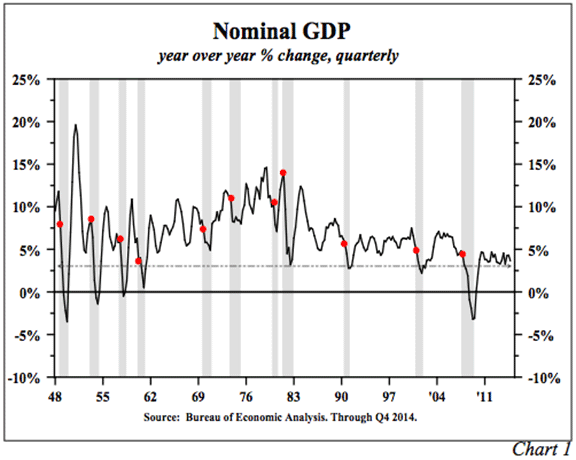
Nominal GDP can be sub-divided into two parts. First is the implicit price deflator, which measures price changes in the economy, and the second is real GDP, which is the change in the volume of goods. Both of these components are volatile, but the recent data shows a lack of strong momentum in economic activity. The year-over-year change in the deflator has accelerated briefly in this expansion, but the peak remained below the cyclical highs of all the expansions in every decade since the 1930s (Chart 2).
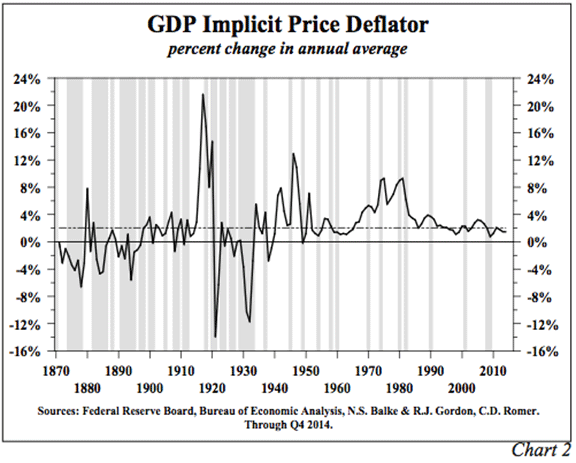
In the past fifteen years, real per capita GDP (nominal GDP divided by the price deflator and population) grew a paltry 1% per annum. This subdued growth rate should be compared to the average expansion of 2.5%, which has been recorded since 1940. The reason for the remarkably slow expansion over the past decade and a half has to do with the accumulation of too much debt. Numerous studies indicate that when total indebtedness in the economy reaches certain critical levels there is a deleterious impact on real per capita growth. Those important over-indebtedness levels (roughly 275% of GDP) were crossed in the late 1990s, which is the root cause for the underperformance of the economy in this latest expansion.
It is interesting to note that in this period of slower growth and lower inflation, long-term Treasury bond yields did rise for short periods as inflationary psychology shifted higher. However, the slow growth meant that the economy was too weak to withstand higher interest rates, and the result was a shift to lower rate levels as the economy slowed. Since the U.S. economy entered the excessive debt range, eight episodes have occurred in which this yield gained 84 basis points or more (Chart 3). Nevertheless, none of these rate surges presaged the start of an enduring cyclical rise in interest rates.
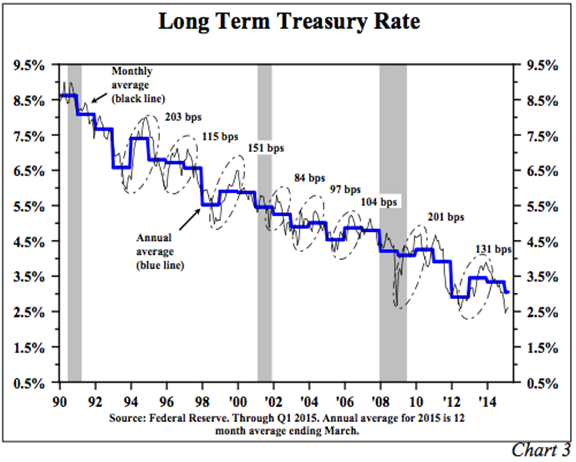
Downturns Without Cyclical Pressures
Many assume that economies can only contract in response to cyclical pressures like rising interest rates and inflation, fiscal restraint, over-accumulation of inventories, or the stock of consumer and corporate capital goods. This idea is valid when debt levels are normal but becomes problematic when debt is excessively high.
Large parts of Europe contracted last year for the third time in the past four years as interest rates and inflation plummeted. The Japanese economy has turned down numerous times over the past twenty years while interest rates were low. Indeed, this has happened so often that nominal GDP in Japan is currently unchanged for the past twenty-three years. This is confirmation that after a prolonged period of taking on excessive debt additional debt becomes counterproductive.
Faltering Productivity is Not Inflationary
Falling productivity does not cause faster inflation. The weaker output per hour is a consequence of the over-indebtedness as much as the other five characteristics mentioned above. Productivity is a complex variable impacted by many cyclical and structural influences. Productivity declines during recessions and declines sharply in deep ones. Nonfarm business productivity has grown at an average rate of 2.2% per annum since the series originated in 1952 (Chart 4). As a general rule the growth rate was above the average during economic expansions and lower than the average in recessions.
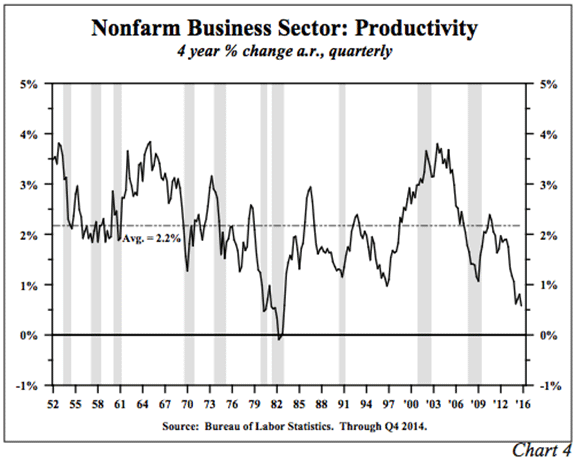
Over the past four years, nonfarm productivity growth has slumped to its lowest levels since 1952, with the exception of the severe recession of 1981- 82. Such a pattern is abnormally weak. Interestingly, the Consumer Price Index was unchanged in the past twelve-month period (Chart 5). In an economy purely dominated by cyclical forces, as opposed to one that is highly leveraged, both productivity and inflation would not be depressed.
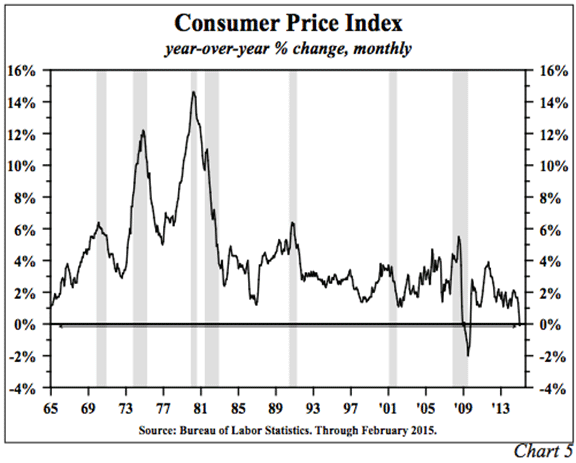
Monetary Policy Is Ineffectual
Monetary policy impacts the overall economy in two areas – price effects and quantity effects. Price effects, or changes in short-term interest rates, are no longer available because rates are near the zero bound. This is a result of repeated quantitative easing by central banks. It is an attempt to lift overly indebted economies by encouraging more borrowing via low interest rates, thus causing even greater indebtedness.
Quantity effects also don’t work when debt levels are excessive. In a non-debt constrained economy, central banks have the capacity, with lags, to exercise control over money and velocity. However, when the debt overhang is excessive, they lose control over both money and velocity. Central banks can expand the monetary base, but this has little or no impact on money growth. Further, central banks cannot control the velocity of money, which declines when there is too much unproductive debt. This happened in the1920s and again after 1997 and is continuing to decline today (Chart 6).
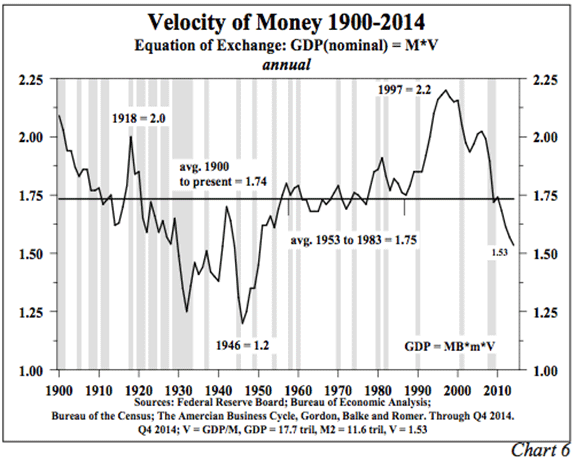
Monetary policy can be used to devalue a country’s currency, but this benefit is short-lived, and to the extent that it works, conditions in other countries are destabilized causing efforts at currency devaluation to invoke retaliation from trading partners.
Inflation Falls So Much That Deflation Risk Rises
Extremely high levels of public and private debt relative to GDP greatly increase the risk of deflation. Deflation, in turn, serves to destabilize an economy that is over-indebted since the borrowers have to pay back loans in harder dollars, which transfers income and wealth from borrowers and creditors.
Such a deflation risk is present in the United States and other important economies of the world. During and after the mild recessions of 1990-91 and 2000-01, the rate of inflation in Europe and the United States fell by an average of 2.5%. With inflation near zero in both economies today, even a mild recession would put both in deflation.
Real Treasury Bond Yields
In periods of extreme over-indebtedness Treasury bond yields can fall to exceptionally low levels and remain there for extended periods. This pattern is consistent with the Fisher equation that states the nominal risk-free bond yield equals the real yield plus expected inflation (i=r+E*). Expected inflation may be slow to adjust to reality, but the historical record indicates that the adjustment inevitably occurs.
The Fisher equation can be rearranged algebraically so that the real yield is equal to the nominal yield minus expected inflation (r=i–E*). Understanding this is critical in determining how unleveraged investors fare. Suppose that this process ultimately reduces the bond yield to 1.5% and expected inflation falls to -1%. In this situation the real yield would be 2.5%. The investor would receive the 1.5% coupon but the coupon income would be supplemented since the dollars received will have a greater purchasing power. A 1.5% nominal yield with real income lift might turn out to be an excellent return in a deflationary environment. Contrarily, earnings growth is problematic in deflation. Businesses must cut expenses faster than the prices of goods or services fall. Firms do not have experience with such an environment because deflation episodes are infrequent. If this earnings squeeze eventuated, then a 1.5% nominal bond yield and 2.5% real yield might be very attractive versus equity returns.
Global Concerns
In our review of historical and present cases of over-indebtedness, we noticed some overlapping tendencies with less regularity that are important to mention.
First, when all major economies face severe debt overhangs, no one country is able to serve as the world’s engine of growth. This condition is just as much present today as it was in the 1920-30s.
Second, currency depreciations result as countries try to boost economic growth at the expense of others. Countries are forced to do this because monetary policy is ineffectual.
Third, devaluations do provide a lift to economic activity, but the benefit is only transitory because other countries that are on the losing end of the initial action retaliate. In the end every party is in worse condition, and the process destabilizes global markets.
Fourth, historically advanced economies have only cured over-indebtedness by a significant multi-year rise in the saving rate or austerity. Historically, austerity arose from one of the following: self-imposition, external demands or fortuitous circumstances.
Overview of Present Conditions
Our expectations for the economy in 2015 are that nominal GDP should grow no more than 3% this year. M2 appears to be expanding around a 6% rate, and velocity is falling at a trend rate of 3%. The risk is that velocity will be even weaker this year; thus, 3% nominal GDP growth may be too optimistic. The ratio of public and private debt to GDP rose last year and economic growth softened. The budget deficit was lower in 2014 than 2013, but gross government debt rose again last year and a further increase is likely in 2015. This is not a positive signpost for velocity. The slower pace in nominal GDP in 2015 would continue the pattern of the past two years when nominal GDP decelerated from 4.6% in 2013 to 3.7% in 2014 on a fourth quarter to fourth quarter basis. Such slow top line growth suggests that both real growth and inflation should be slower than last year.
Many factors can cause intermittent increases in Treasury yields, but economic and inflation fundamentals are too weak for yields to remain elevated. Therefore, the environment for holding long-term Treasury bond positions should be most favorable in 2015.
Van R. Hoisington
Lacy H. Hunt, Ph.D.
Like Outside the Box?
Sign up today and get each new issue delivered free to your inbox.
It's your opportunity to get the news John Mauldin thinks matters most to your finances.
John Mauldin Archive |
© 2005-2022 http://www.MarketOracle.co.uk - The Market Oracle is a FREE Daily Financial Markets Analysis & Forecasting online publication.



